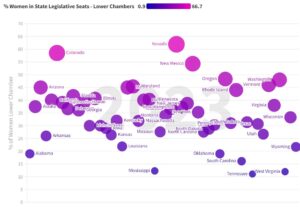Moving Beyond the Good Ol’ Boys Club: Recent Trends in Women’s Representation in State Legislatures
Originally published by for Sabato’s Crystal Ball, University of Virginia Center for Politics
KEY POINTS FROM THIS ARTICLE
— The percentage of women in state legislatures has increased in recent years. However, there is still a significant gender gap in most states as women have not reached parity in representation.
— The majority of women in state legislatures are Democrats. While more Republican women ran for office in 2022 than in previous years, that didn’t amount to closing the gender gap in representation.
— The percentage of women in state legislatures has increased more in Western and Northeastern states than in Midwestern and Southern states. This is likely due to a number of factors, including the political climate, the level of motivation and activism among women, and the availability of resources for women’s campaigns.
Changes in legislatures
In a special election on May 16, Democrats maintained a narrow majority in the Pennsylvania House of Delegates. As a result, the party will be able to continue to exert control over how the lower chamber of the state legislature will handle reproductive, gun, and voting rights legislation. With Republicans still holding the Pennsylvania Senate, the House could also provide an assist to Democratic Gov. Josh Shapiro in budget negotiations. In House District 163, Democratic candidate Heather Boyd defeated Republican candidate Katie Ford for a vacancy created by Democratic Rep. Mike Zabel, who resigned from the legislature after multiple people, including a lobbyist and other lawmakers accused him of sexual harassment. That two women vied for the House seat is a sign of change for a state legislature that has been accused in the past by other women lawmakers of having a paternalistic culture and being an “Old Boys Club.”
But it’s not just Pennsylvania that’s changing. In early April, as the Tennessee House was about to vote on expulsion resolutions for Reps. Justin Pearson (D-Memphis), Justin Jones (D-Nashville), and Gloria Johnson (D-Knoxville) for leading a protest against gun violence on the House floor on March 30, Johnson told her colleagues in the state legislature that they should welcome a new generation of lawmakers who are going to look and do things differently because they “are fighting like hell” for their constituents. Meanwhile, in Nebraska, a bill that would ban abortion around the 6th week of pregnancy failed to get a crucial 33rd vote to break a filibuster in the technically nonpartisan and unicameral state legislature when Republican Sen. Merv Riepe abstained. When Riepe got pushback on an amendment he introduced to extend the proposed ban from 6 to 12 weeks, he told his Republican colleagues that reproductive rights will have women voting them out of office. He offered as evidence his own narrowing margins of victory against a Democratic woman challenger in a post-Dobbs election as a preview of what’s to come. In South Carolina, where women make up only 11% of the upper chamber, the opposition of all five women, including three Republicans, led to the failure of a near-total abortion ban by a 22-21 vote in April. While a comparatively less strict fetal heartbeat ban did eventually pass in May with the continued opposition of the five women, that they were able to prevent the passage of a stricter bill is another example of how women in decision-making positions can impact policy outcomes.
These vignettes got me thinking about how representation in state legislatures is (or is not) changing and prompted us to do a series examining trends. In this first installment, I examine how women’s representation has changed in American state legislatures since 1975. To analyze change in women’s representation in state legislatures from 1975 to 2023, I compiled data from several sources, including the National Conference of State Legislatures, Ballotpedia, and the Center for American Women and Politics (CAWP) at the Eagleton Institute of Politics at Rutgers University. Political science scholarship has shown that descriptive representation matters. Specifically, scholarship on gender and politics has shown that men and women have different policy preferences, and that female legislators are more likely to emphasize women’s issues and adopt women-friendly policies (see a good review of the literature here).
